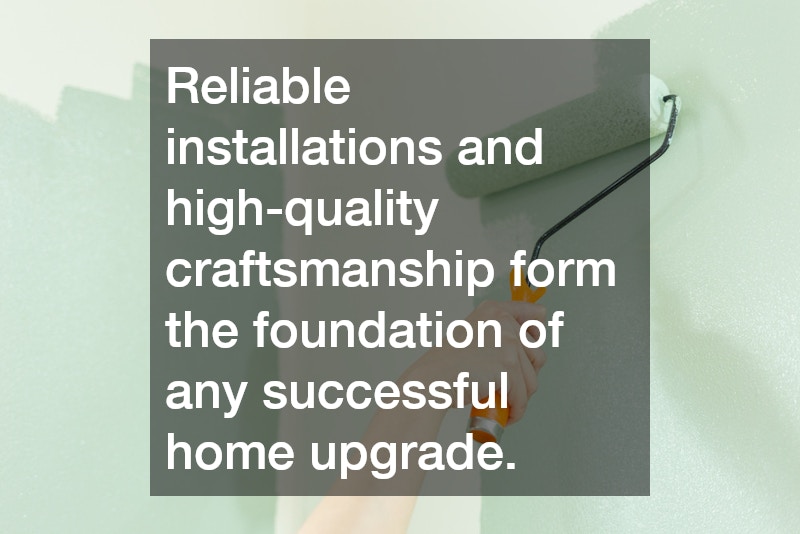Renovating a home can be one of the most rewarding experiences for homeowners, offering the chance to improve functionality, comfort, and aesthetics. Whether it’s modernizing outdated spaces, enhancing energy efficiency, or increasing property value, home improvement projects require thoughtful planning and skilled execution. Smart renovations balance creativity with practicality, ensuring that every change contributes to long-term satisfaction. Reliable installations and high-quality craftsmanship form the foundation of any successful home upgrade. This guide explores essential areas of renovation and provides actionable advice to help homeowners make informed, lasting decisions.
Planning Your Home Renovation for Success
Before starting any project, a successful home renovation begins with careful planning. A well-structured plan ensures that the project stays within budget, meets deadlines, and delivers the desired results.
Set clear goals. Start by identifying which areas of the home require improvement and why. Some homeowners focus on increasing comfort, while others aim to boost resale value. Understanding the purpose behind each renovation helps prioritize spending and design choices.
Create a realistic budget. Research material and labor costs, adding a contingency fund of around 10–15% to handle unexpected expenses. A realistic budget prevents mid-project surprises and helps maintain financial stability.
Vet contractors carefully. Choose licensed, insured professionals with positive reviews and transparent pricing. Always request written estimates and check references before signing contracts.
When it comes to bath remodeling, planning is especially important. Consider the functionality of the layout, water efficiency, and the durability of materials. A small bathroom can be transformed through strategic design—such as using floating vanities, glass shower doors, and bright lighting—to make the space feel larger.
Similarly, kitchen remodel services can dramatically change how a household operates. The kitchen is often the most used room in the home, and poor planning can lead to inefficiency. Homeowners should think about workflow, storage, and lighting when creating a new layout. A professional remodeler can help reconfigure plumbing, electrical, and cabinetry to ensure both beauty and functionality.
Pro tip: Keep communication open with your contractor throughout the project. Regular updates, walkthroughs, and clear expectations can prevent misunderstandings and ensure that every detail aligns with your vision.

Upgrading Everyday Spaces With Purpose
Home renovation should go beyond aesthetics—it should enhance how you live. Upgrading kitchens and bathrooms provides the most noticeable improvements because these rooms serve as daily-use spaces.
For bathrooms, focus on durable materials that resist humidity and wear. Modern tile flooring, water-saving fixtures, and proper ventilation can all make a significant difference. Stylish finishes, such as matte black faucets or quartz countertops, add sophistication without compromising function.
For kitchens, design upgrades can make the space both beautiful and efficient. Consider:
- Ergonomic design: Place the sink, stove, and refrigerator in a triangular layout for optimal workflow.
- Smart storage: Pull-out drawers, lazy Susans, and vertical pantry shelving maximize space.
- Lighting layers: Combine ambient, task, and accent lighting to brighten the workspace and enhance ambiance.
When tackling bath remodeling, remember that small details—like grout color, hardware, and mirror placement—can make a big visual impact. Similarly, kitchen remodel services should focus on balancing design trends with timeless appeal. Durable materials like quartz, porcelain, and solid wood cabinetry ensure longevity and ease of maintenance.
Homeowners who plan these spaces with function in mind often find their daily routines improved and their property values increased.
Choosing Energy-Efficient Openings for Comfort and Savings
Modernizing your home’s openings—especially windows and doors—can lead to significant energy savings. Older models tend to allow drafts, moisture, and noise, making homes less comfortable and more expensive to heat or cool.
High-performance windows and doors offer better insulation, helping regulate indoor temperatures year-round. When shopping for replacements, look for:
- Energy Star ratings that confirm efficiency.
- Double- or triple-pane glass to reduce noise and heat transfer.
- Durable frames made from vinyl, fiberglass, or composite materials.
Upgrading to an energy-efficient patio door not only enhances curb appeal but also connects indoor and outdoor spaces seamlessly. Sliding or French-style patio doors can flood rooms with natural light while improving energy control when properly sealed.
Maintenance tip: Inspect caulking, seals, and hardware annually to prevent air leaks and extend the life of your installations. Regular cleaning of window tracks and hinges also prevents rust and ensures smooth operation.

Securing Your Home With Durable Exterior Solutions
A safe home starts with strong entryways, and investing in high-quality doors is a critical step toward security and peace of mind. Impact doors are engineered to withstand extreme weather conditions, including heavy storms, high winds, and flying debris, making them particularly valuable in coastal or hurricane-prone areas. Their reinforced frames and laminated or tempered glass provide not only protection from physical threats but also enhanced energy efficiency, reducing drafts and helping maintain a stable indoor temperature year-round.
When selecting exterior doors, homeowners should carefully evaluate several key factors:
-
Assess your climate: Homes in regions with frequent storms or strong winds benefit from impact-rated doors that meet rigorous performance standards. These doors are tested to withstand repeated pressure and high-speed projectiles, ensuring safety during extreme events.
-
Check local building codes: Many municipalities require specific door types or certifications to comply with safety regulations. Ensuring compliance not only protects residents but may also be necessary for insurance coverage.
-
Consider style and visibility: Modern impact doors come in a variety of finishes, colors, and glass designs, allowing homeowners to balance aesthetics with functionality. Decorative glass options can maximize natural light while maintaining security.
A properly installed patio door is another important element of home safety and convenience. Look for models with multi-point locking systems, reinforced tracks, and shatter-resistant glass to prevent unauthorized access and minimize water intrusion. Weatherstripping and proper alignment are essential for keeping out drafts and protecting the interior from the elements.
Professional installation is crucial for both impact and patio doors. Incorrect fitting can result in gaps, misalignment, or weakened structural support, which compromise safety and efficiency. Qualified technicians ensure accurate measurements, secure mounting, and precise sealing, guaranteeing that doors function as intended. Investing in expert installation may cost more initially, but it ensures long-term durability, improved security, and peace of mind for years to come.
Creating Comfort With Customized Window Treatments
Window coverings are more than decorative—they play a vital role in energy management, comfort, and overall home functionality. With the right window treatments, homeowners can control light, privacy, and temperature with ease, while also enhancing the aesthetic appeal of any room.
Some popular options include:
-
Blinds: Available in wood, faux wood, or aluminum, blinds offer precise, adjustable light control. Modern cordless options increase safety for homes with children and pets.
-
Shades: Roller, cellular, or Roman shades not only provide clean lines and sleek designs but also improve insulation. Cellular shades, in particular, trap air and can significantly reduce heat transfer.
-
Curtains and drapes: Available in countless fabrics, curtains and drapes add warmth, texture, and elegance. Many come with thermal lining or blackout options to prevent heat loss, reduce glare, and protect furnishings from UV damage.
-
Shutters: Solid and durable, shutters are a timeless choice that can last for decades. They enhance resale value and are available in a variety of finishes to match both contemporary and traditional interiors.
When paired with energy-efficient windows and doors, window treatments can reduce heating and cooling costs substantially. Thermal curtains and cellular shades block drafts in winter and minimize heat gain in summer, potentially saving homeowners hundreds of dollars annually. Additionally, layering treatments—such as pairing sheer curtains with blackout drapes—provides flexibility for controlling light and privacy throughout the day.
Window coverings also improve indoor acoustics by dampening outside noise, which is especially beneficial in urban areas or homes near busy streets. They help protect furniture, flooring, and artwork from fading caused by sunlight exposure.
Investing in well-chosen, professionally installed window treatments is a smart, long-term home improvement. By combining style, function, and energy efficiency, homeowners create spaces that are more comfortable, aesthetically pleasing, and cost-effective year-round.
Maintaining and Repairing Key Entry Systems
Garage systems often go unnoticed until something breaks. Yet, they’re essential for safety, convenience, and security. Keeping them in top condition prevents larger—and more expensive—issues down the road. Beyond providing access, a well-maintained garage door protects your home from intruders, weather damage, and energy loss.
Regular garage door repair should be part of every homeowner’s maintenance plan. Signs that service is needed include:
-
Unusual noises during operation, such as grinding or squeaking
-
Uneven door movement or doors that stick in certain positions
-
Sagging or bent panels that affect alignment
-
Slow response to remote controls or wall switches
Professional garage door service goes beyond simple fixes. Technicians perform comprehensive inspections, checking springs, cables, rollers, and openers for wear or imbalance. They also lubricate moving parts, adjust alignment, and test safety sensors to ensure smooth and secure operation. Regular maintenance can catch small problems before they become costly emergencies, saving both time and money in the long run.
DIY maintenance can complement professional service. Homeowners can tighten loose hardware, clean tracks to remove debris, and check the door balance by manually lifting it to ensure it moves smoothly. However, complex components like torsion springs or motorized openers should always be handled by trained professionals due to the high risk of injury or damage.
In addition, adding features such as smart openers, battery backups, or automatic locking mechanisms can further enhance security and convenience. Pairing routine maintenance with these upgrades ensures the garage system functions reliably while also increasing the home’s overall safety and value.
Preventive care not only extends the lifespan of your garage door but also ensures that your home’s primary entry point remains safe, reliable, and energy-efficient throughout the year. Proactive attention today avoids costly repairs and unexpected emergencies tomorrow.

Investing in Long-Term Reliability With Professional Installations
Reliable installation determines how well home features perform and how long they last. Even the highest-quality materials won’t function properly if they’re poorly installed. That’s why working with experienced, certified professionals is non-negotiable. Proper installation ensures that everything from doors and windows to flooring and cabinetry operates smoothly, looks great, and provides long-term durability.
When it comes to garage door installation, precision is critical. A misaligned track, unbalanced spring, or incorrectly set opener can lead to premature wear, operational failure, or even serious safety hazards. Homeowners should verify that installers measure openings accurately, check for level alignment, and test the door multiple times under various conditions before considering the job complete. Proper adjustments to tension, alignment, and hardware placement not only ensure smooth operation but also extend the life of the entire system.
Similarly, glass installation requires careful expertise. Whether installing shower enclosures, windows, or decorative panels, professionals must handle materials carefully to prevent chips, cracks, or improper sealing. They also account for expansion and contraction caused by temperature changes, ensuring long-term stability. Correctly sealed glass prevents drafts, leaks, and potential water damage, while also maintaining aesthetic appeal and safety standards.
When hiring installation professionals, homeowners should:
-
Request proof of licensing, insurance, and manufacturer certification.
-
Ask for a written warranty covering both materials and labor.
-
Read reviews, check references, and verify the company’s reputation.
-
Ensure the contractor has experience with the specific product being installed.
While quality installation may cost more upfront, it prevents long-term expenses related to leaks, drafts, or mechanical failures. A properly installed feature maintains manufacturer warranties, enhances safety, and delivers reliable performance for years to come. Investing in skilled professionals ultimately protects your home, your budget, and your peace of mind.
Building a Smart Home for the Future
Today’s homeowners have more opportunities than ever to integrate smart technologies into their living spaces. Beyond convenience, these systems offer real savings through automation and energy efficiency.
Consider the following smart upgrades:
-
Automated lighting and thermostats: Adjust automatically to reduce energy waste and optimize comfort.
-
Smart window coverings: Timed to open and close with daylight cycles for natural climate control.
-
Security systems: Offer mobile alerts and remote monitoring for peace of mind.
-
Voice-activated appliances: Simplify daily tasks and enhance accessibility for all ages.
To make the most of these innovations, plan wiring and connectivity early in the renovation process. A reliable Wi-Fi network and structured cabling ensure that all systems communicate efficiently. It’s also wise to choose devices that are compatible across platforms—this flexibility makes it easier to upgrade individual components later without reworking the entire system.
Integrating technology doesn’t mean sacrificing style—many modern devices are designed to blend seamlessly with contemporary or traditional decor.
Smart renovation is ultimately about foresight: investing in upgrades that meet current needs while preparing for future possibilities. With thoughtful planning, homeowners can create a connected, energy-smart environment that grows with technological advancements.
Home renovation is both an art and a science. It requires balancing creativity, functionality, and reliability at every stage. By planning carefully, choosing trusted professionals, and investing in high-quality installations, homeowners can transform their spaces into more efficient, comfortable, and secure environments.
Every improvement—whether it’s a remodeled kitchen, a new entryway, or an upgraded garage system—contributes to a better living experience and lasting property value. Smart renovation isn’t just about change; it’s about building a foundation for years of comfort and confidence in your home.

